Exploring Post-Machining Alternatives Under Dry Conditions for Thin-Walled Additive Manufacturing Components Aided by Infrared Thermography
Abstract
1. Introduction
2. Materials and Methods
2.1. Materials and Specimens
2.2. Test Methodology
2.2.1. Initial Setup Trials
2.2.2. Setup Variations
2.2.3. Surface Roughness Determination
2.2.4. Temperature Measurement by Means of Thermal Imaging
3. Results and Discussion
3.1. Setup 1: Effect of Cutting Parameters on Surface Roguhness and Temperature
3.1.1. Trajectory Changes Affectation
3.1.2. Influence of Cutting Tool Wear on Recorded Temperature
3.2. Setup 2: Effect of Cutting Parameters on Surface Roughness and Temperature Compared with Setup 1
3.2.1. Diameter Change: Setup 1 vs. Setup 2
3.2.2. Influence of Cutting Tool Wear: Setup 1 vs. Setup 2
3.2.3. Damage in the Cutting Tools: Setup 1 vs. Setup 2
3.2.4. Comparison of Vise Fixation vs. 3D-Printed Thin-Wall Support for Setup 2
4. Conclusions
- Changes in feed per tooth (Fz) and axial depth of cut (Ap) significantly influence tool wear and temperature. While varying Fz and change in diameter of the cutting tool did not have a major impact, increasing Ap led to more noticeable tool degradation, especially in terms of surface roughness. In future works, optimizing these parameters can lead to more energy-efficient and environmentally friendly machining processes.
- Among the two roughness parameters, Ra (arithmetic average roughness) and RSM (root mean square roughness), the RSM parameter proved to be more sensitive and reliable in detecting surface finish differences. As a result, it is considered more dependable for comparison with infrared camera temperature readings, offering a precise method for monitoring sustainability-driven improvements in surface finish quality.
- For Setup 1, it was shown that the linear and helicoidal trajectories provided better cooling and reduced tool wear compared to trochoidal trajectories. Trochoidal paths resulted in higher temperatures and more severe tool damage, indicating that optimizing cutting trajectories can lead to more energy-efficient and sustainable production processes.
- In Setup 2, it was demonstrated that the method of fixing the component, whether with a vise or a 3D-printed thin-wall support, had an effect on tool performance. The 3D-printed support led to increased tool wear, potentially due to vibrations during the milling process. However, both methods performed better than Setup 1, emphasizing the role of material and system stability in optimizing energy use and process sustainability.
- As cutting tool wear/damage increased, infrared temperature readings showed a rise in temperature, which correlated with increased RSM roughness value of the Ti-6Al-4V surface parameters due to the increment of vibrations to worsened surface finishes. These findings underscore the importance of minimizing tool wear to enhance operational efficiency and reduce material waste.
- The use of infrared cameras has been confirmed as an effective tool for monitoring tool condition and surface quality, especially in dry machining conditions, where traditional lubrication is absent. This technique aids in detecting temperature increases that signal potential issues, such as tool wear or surface roughness degradation, while promoting more sustainable practices by eliminating the need for chemical lubricants.
Author Contributions
Funding
Data Availability Statement
Acknowledgments
Conflicts of Interest
References
- Peters, M.; Hemptenmacher, J.; Kumpfert, J.; Leyens, C. Structure and Properties of Titanium and Titanium Alloys; Wiley-VCH Verlag GmbH & Co., KGaA: Weinheim, Germany, 2003; pp. 1–36. [Google Scholar] [CrossRef]
- Srivastava, M.; Jayakumar, V.; Udayan, Y.; Sathishkumar, M.; Muthu, S.M.; Gautam, P.; Nag, A. Additive manufacturing of Titanium alloy for aerospace applications: Insights into the process, microstructure, and mechanical properties. Appl. Mat. Today 2024, 41, 102481. [Google Scholar] [CrossRef]
- Nguyen, H.D.; Pramanik, A.; Basak, A.K.; Dong, Y.; Prakash, C.; Debnath, S.; Shankar, S.; Jawahir, I.S.; Dixit, S.; Buddhi, D. A critical review on additive manufacturing of Ti-6Al-4V alloy: Microstructure and mechanical properties. J. Mater. Res. Technol. 2022, 18, 4641–4661. [Google Scholar] [CrossRef]
- Al-Rubaie, K.S.; Melotti, S.; Rabelo, A.; Paiva, J.M.; Elbestawi, M.A.; Veldhuis, S.C. Machinability of SLM-produced Ti6Al4V titanium alloy parts. J. Manuf. Process. 2020, 57, 768–786. [Google Scholar] [CrossRef]
- Ni, C.; Zhu, L.; Zheng, Z.; Zhang, J.; Yang, Y.; Hong, R.; Bai, Y.; Lu, W.F.; Wang, H. Effects of machining surface and laser beam scanning strategy on machinability of selective laser melted Ti6Al4V alloy in milling. Mater. Des. 2020, 194, 108880. [Google Scholar] [CrossRef]
- Boyer, R.R. An overview on the use of titanium in the aerospace industry. Mater. Sci. Eng. A 1996, 213, 103–114. [Google Scholar] [CrossRef]
- Kishawy, H.A.; Hosseini, A. Machining Difficult-to-Cut Materials Basic Principles and Challenges; Springer: Oshawa, ON, Canada, 2019. [Google Scholar] [CrossRef]
- Pimenov, D.Y.; Mia, M.; Gupta, M.K.; Machado, A.R.; Tomaz, I.V.; Sarikaya, M.; Wojciechowski, S.; Mikolajczyk, T.; Kapłonek, W. Improvement of machinability of Ti and its alloys using cooling-lubrication techniques: A review and future prospect. J. Mater. Res. Technol. 2021, 11, 719–753. [Google Scholar] [CrossRef]
- Shokoohi, Y.; Khosrojerdi, E.; Rassolian Shiadhi, B.H. Machining and ecological effects of a new developed cutting fluid in combination with different cooling techniques on turning operation. J. Clean. Prod. 2015, 94, 330–339. [Google Scholar] [CrossRef]
- Samukov, A.; Cherkasova, M.; Kuksov, M.; Dmitriev, S. Metal chips preparation for utilization using advanced reagents. In IOP Conference Series: Earth and Environmental Science; IOP Publishing: Bristol, UK, 2021; Volume 938, p. 012009. [Google Scholar] [CrossRef]
- Lei, Y.; Zhang, Y.; Newkirk, J.W.; Liou, F.; Thomas, E.; Baker, A. Investigation of Machining Coolant Residue Cleaning Methods for Ti6Al4V Part Fabrication through Hybrid Manufacturing Process. Manuf. Lett. 2018, 16, 10–13. [Google Scholar] [CrossRef]
- Isaev, A.V.; Grechishnikov, V.A.; Petr, P.; Mihail, K.; Yuriy, I.; Andrey, V. Machining of Thin-walled Parts Produced by Additive Manufacturing Technologies. Procedia cIRP 2016, 41, 1023–1026. [Google Scholar] [CrossRef]
- Pegues, J.; Roach, M.; Williamson, R.S.; Shamsaei, N. Surface roughness effects on the fatigue strength of additively manufactured Ti-6Al-4V. Int. J. Fatigue 2019, 116, 543–552. [Google Scholar] [CrossRef]
- Bin Anwar Fadzil, A.F.; Pramanik, A.; Basak, A.K.; Prakash, C.; Shankar, S. Role of surface quality on biocompatibility of implants—A review. Ann. 3D Print. Med. 2022, 8, 100082. [Google Scholar] [CrossRef]
- Rahulan, N.; Sreekala Sharma, S.; Rakesh, N.; Sambhu, R. A short review on mechanical properties of SLM titanium alloys based on recent research works. Mater. Today. 2022, 56, A7–A12. [Google Scholar] [CrossRef]
- Zgórniak, P.; Stachurski, W.; Ostrowski, D. Application of Thermographic Measurements for the Determination of the Impact of Selected Cutting Parameters on the Temperature in the Workpiece During Milling Process. J. Mech. Eng. 2016, 62, 657–664. [Google Scholar] [CrossRef][Green Version]
- Ramirez-Nunez, J.A.; Trejo-Hernandez, M.; Romero-Troncoso, R.J.; Herrera-Ruiz, G.; Osornio-Rios, R.A. Smart-sensor for tool-breakage detection in milling process under dry and wet conditions based on infrared thermography. Int. J. Adv. Manuf. Technol. 2018, 97, 1753–1765. [Google Scholar] [CrossRef]
- Armendia, M.; Garay, A.; Villar, A.; Davies, M.A.; Arrazola, P.J. High bandwidth temperature measurement in interrupted cutting of difficult to machine materials. CIRP Ann. 2010, 59, 97–100. [Google Scholar] [CrossRef]
- De Maddis, M.; Lunetto, V.; Razza, V.; Russo Spena, P. Infrared Thermography for Investigation of Surface Quality in Dry Finish Turning of Ti6Al4V. Metals 2022, 12, 154. [Google Scholar] [CrossRef]
- Sales, W.F.; Diniz, A.E.; Machado, A.R. Application of cutting fluids in machining processes. J. Barz. Soc. Mech. Sci. 2001, 23, 224–240. [Google Scholar] [CrossRef]
- Khanna, N.; Zadafiya, K.; Patel, T.; Kaynak, Y.; Rashid, R.A.R.; Vafadar, A. Review on machining of additively manufactured nickel and titanium alloys. J. Mater. Res. Technol. 2021, 15, 3192–3221. [Google Scholar] [CrossRef]
- Campos, F.O.; Araujo, A.C.; Munhoz, A.L.J.; Kapoor, S.G. The influence of additive manufacturing on the micromilling machinability of Ti6Al4V: A comparison of SLM and commercial workpieces. J. Manuf. Process. 2020, 60, 299–307. [Google Scholar] [CrossRef]
- Khaliq, W.; Zhang, C.; Jamil, M.; Khan, A.M. Tool wear, surface quality, and residual stresses analysis of micro-machined additive manufactured Ti–6Al–4V under dry and MQL conditions. Tribol. Int. 2020, 151, 106408. [Google Scholar] [CrossRef]
- Zhang, H.; Dang, J.; Ming, W.; Xu, X.; Chen, M.; An, Q. Cutting responses of additive manufactured Ti6Al4V with solid ceramic tool under dry high-speed milling processes. Ceram. Int. 2020, 46, 14536–14547. [Google Scholar] [CrossRef]
- X1. UNE-EN ISO 4287; Geometrical product specifications (GPS). Surface texture: Profile method. Terms, definitions and surface texture parameters (ISO 4287:1997 + Technical Corrigendum 1). International Organization for Standardization (ISO): Geneva, Switzerland, 1997.
- X2. UNE-EN ISO 25178-2; Geometrical product specifications (GPS)—Surface texture: Areal—Part 2: Terms, definitions and surface texture parameters (ISO 25178-2:2021). International Organization for Standardization (ISO): Geneva, Switzerland, 2021.
- González-Fernández, L.; Risueño, E.; Pérez-Sáez, R.B.; Tello, M.J. Infrared normal spectral emissivity of Ti–6Al–4V alloy in the 500–1150 K temperature range. J. Alloys Compd. 2012, 541, 144–149. [Google Scholar] [CrossRef]
- Veiga, F.; Del Val, A.G.; Suárez, A.; Alonso, U. Analysis of the Machining Process of Titanium Ti6Al-4V Parts Manufactured by Wire Arc Additive Manufacturing (WAAM). Materials 2020, 13, 766. [Google Scholar] [CrossRef]
- Jaffery, S.H.; Khan, M.; Nadeem A Sheikh, N.A.; Mativenga, P. Wear mechanism analysis in milling of Ti-6Al-4V alloy. Proc. Inst. Mech. Eng. Part B J. Eng. Manuf. 2013, 227, 1148–1156. [Google Scholar] [CrossRef]
- Niaki, F.A.; Pleta, A.; Mears, L.; Potthoff, N.; Bergmann, J.A.; Wiederkehr, P. Trochoidal milling: Investigation of dynamic stability and time domain simulation in an alternative path planning strategy. Int. J. Adv. Manuf. Technol. 2019, 102, 1405–1419. [Google Scholar] [CrossRef]
- Luo, M.; Hah, C.; Hafeez, H.M. Four-axis trochoidal toolpath planning for rough milling of aero-engine blisks. Chin. J. Aeronaut. 2019, 32, 2009–2016. [Google Scholar] [CrossRef]
- Dong, Y.; Li, S.; Zhang, Q.; Li, P.; Jia, Z.; Li, Y. Modeling and Analysis of Micro Surface Topography from Ball-End Milling in a Trochoidal Milling Mode. Micromachines 2021, 12, 1203. [Google Scholar] [CrossRef]
- García-Hernández, C.; Garde-Barace, J.-J.; Valdivia-Sánchez, J.-J.; Ubieto-Artur, P.; Bueno-Pérez, J.-A.; Cano-Álvarez, B.; Alcázar Sánchez, M.-Á.; Valdivia-Calvo, F.; Ponz-Cuenca, R.; Huertas-Talón, J.-L.; et al. Trochoidal Milling Path with Variable Feed. Application to the Machining of a Ti-6Al-4V Part. Mathematics 2021, 9, 2701. [Google Scholar] [CrossRef]
- Zhou, X.; Zhou, J.; Qi, Q.; Zhang, C.; Zhang, D. Effects of Toolpath Parameters on Engagement Angle and Cutting Force in Ellipse-Based Trochoidal Milling of Titanium Alloy Ti-6Al-4V. Appl. Sci. 2023, 13, 6550. [Google Scholar] [CrossRef]
- Sousa, V.F.C.; Silva, F.J.G. Recent Advances on Coated Milling Tool Technology—A Comprehensive Review. Coatings 2020, 10, 235. [Google Scholar] [CrossRef]
- Zhao, J.; Liu, Z.; Wang, B.; Hu, J.; Wan, Y. Tool coating effects on cutting temperature during metal cutting processes: Comprehensive review and future research directions. Mech. Syst. Signal Process. 2021, 150, 107302. [Google Scholar] [CrossRef]
- Harun, S.; Burhanuddin, Y.; Ibrahim, G.A. The Effect of Cutting Parameters on Surface Roughness and Morphology of Ti-6Al-4V ELI Titanium Alloy during Turning with Actively Driven Rotary Tools. J. Manuf. Mater. Process. 2022, 6, 105. [Google Scholar] [CrossRef]

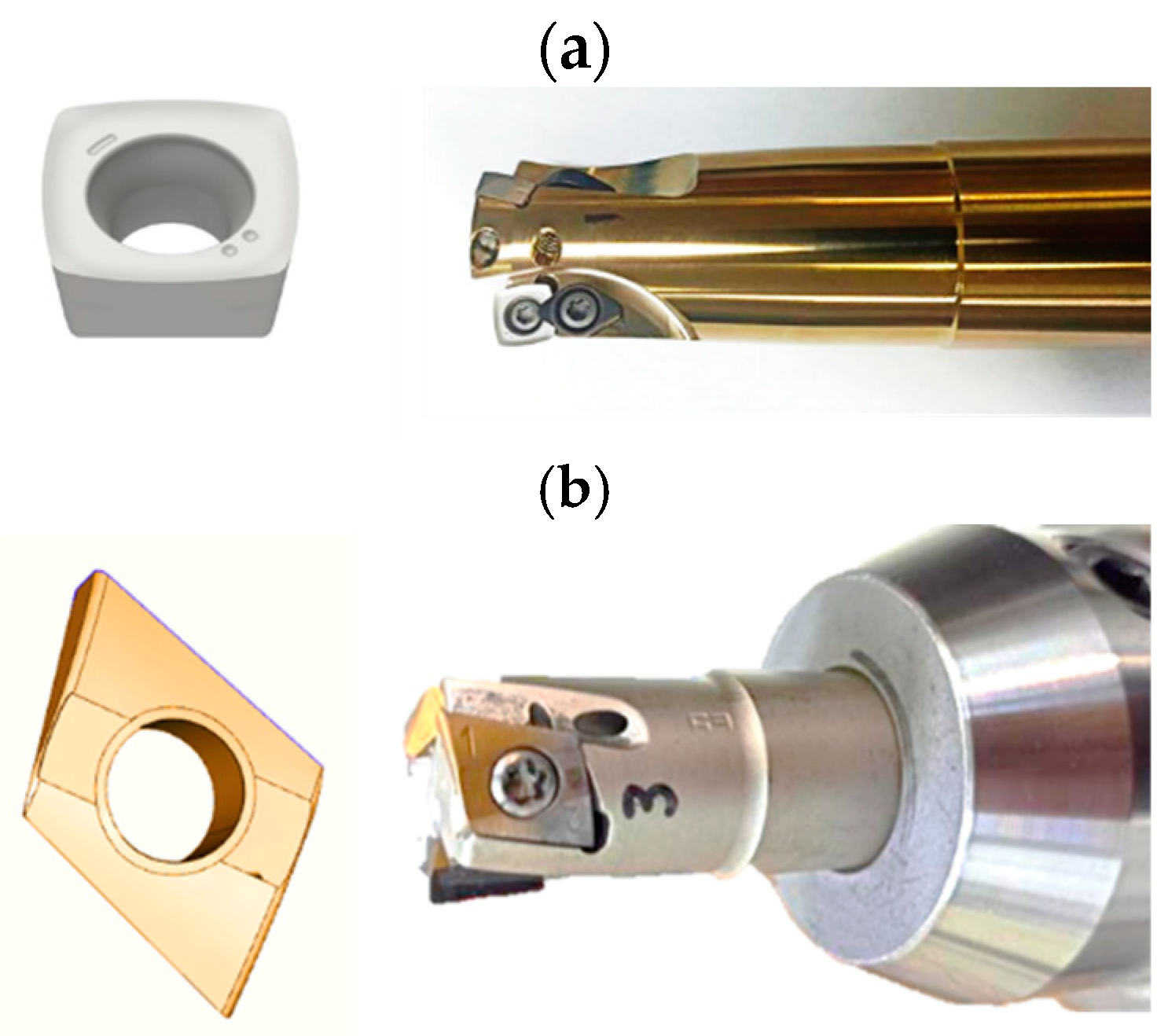


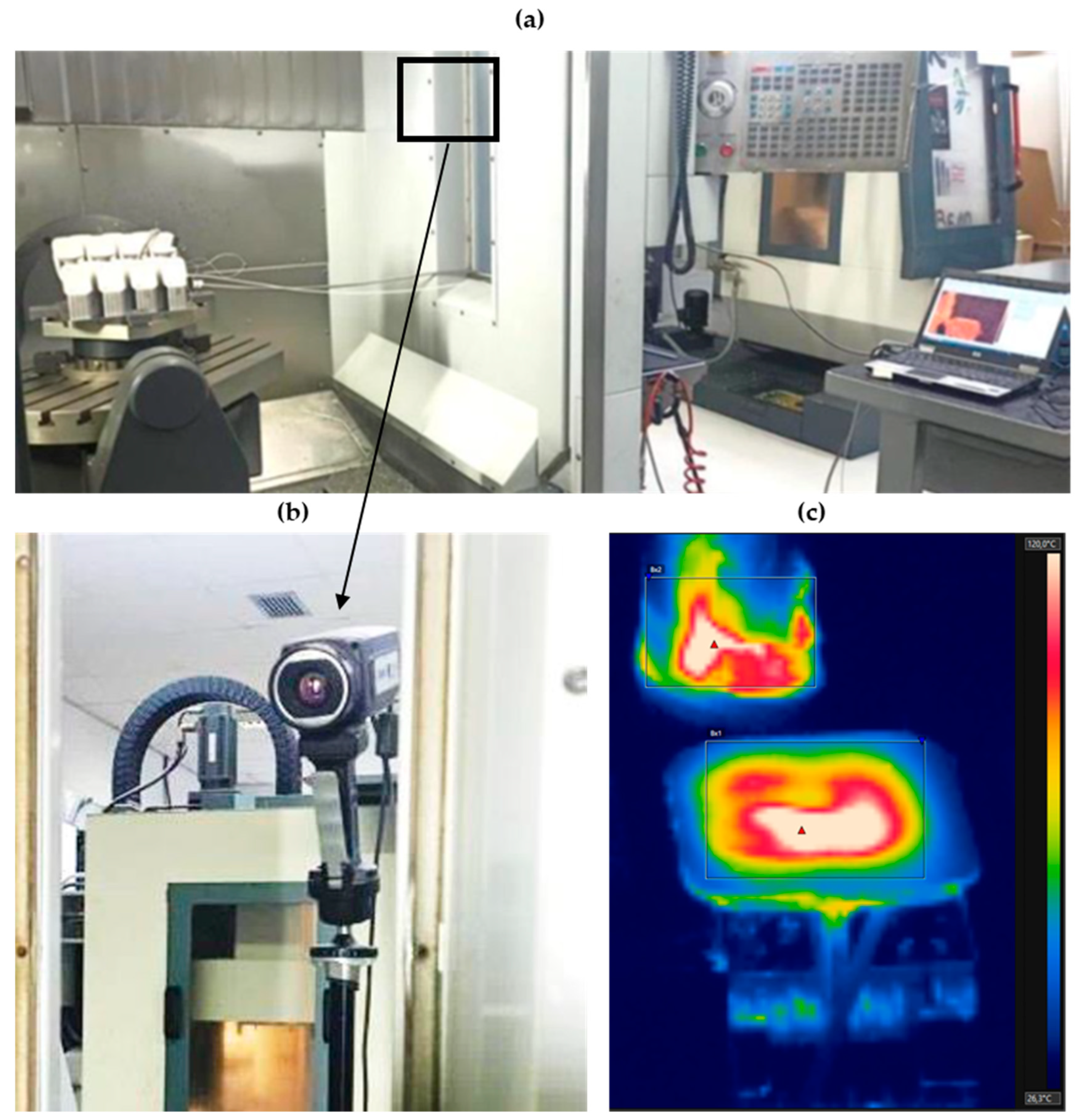
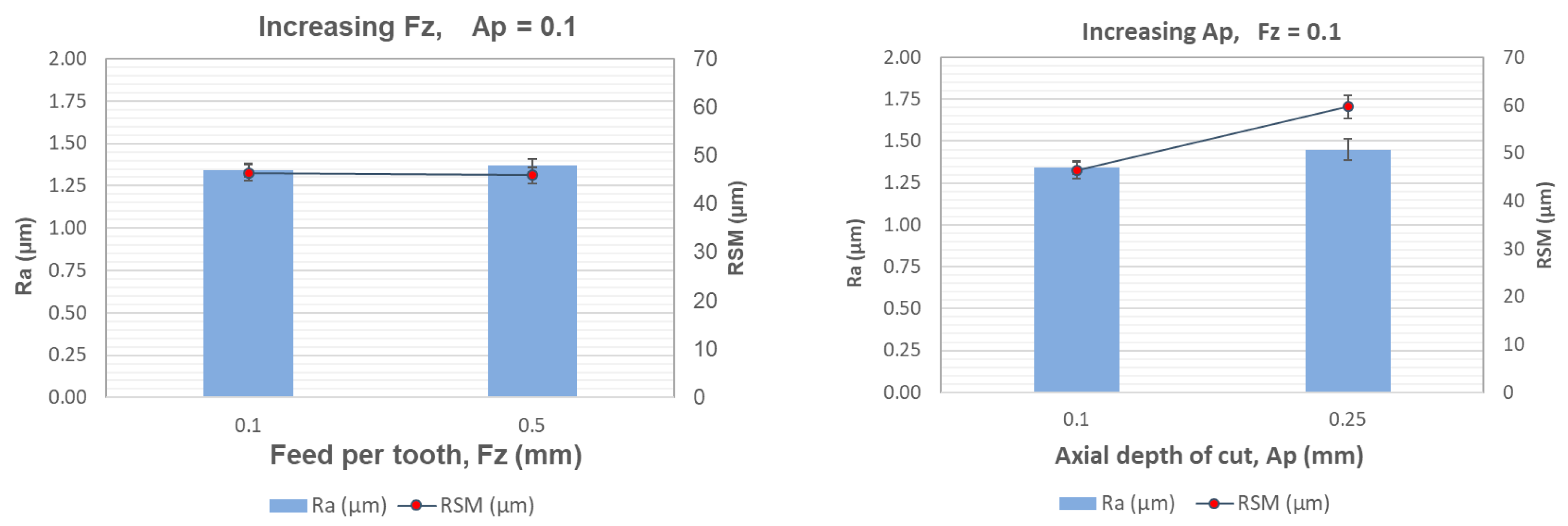
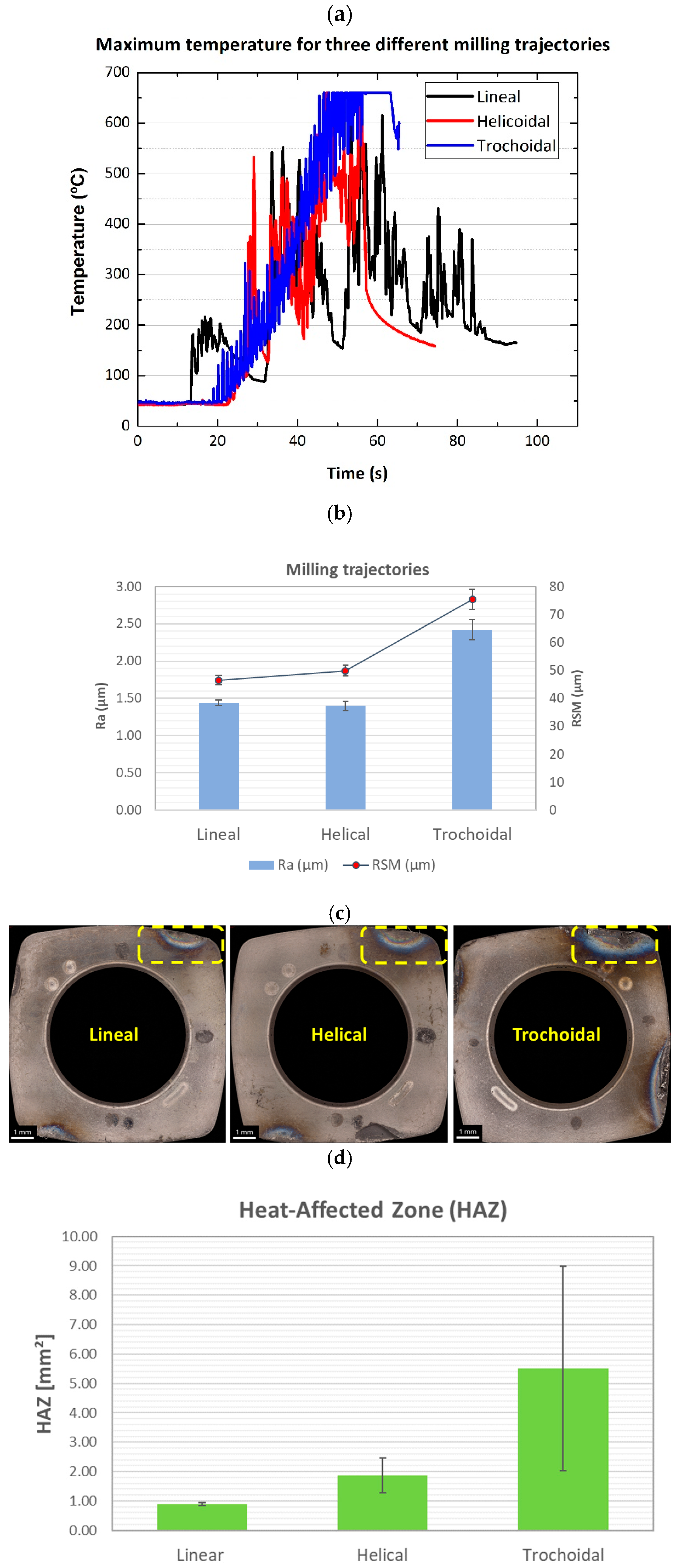

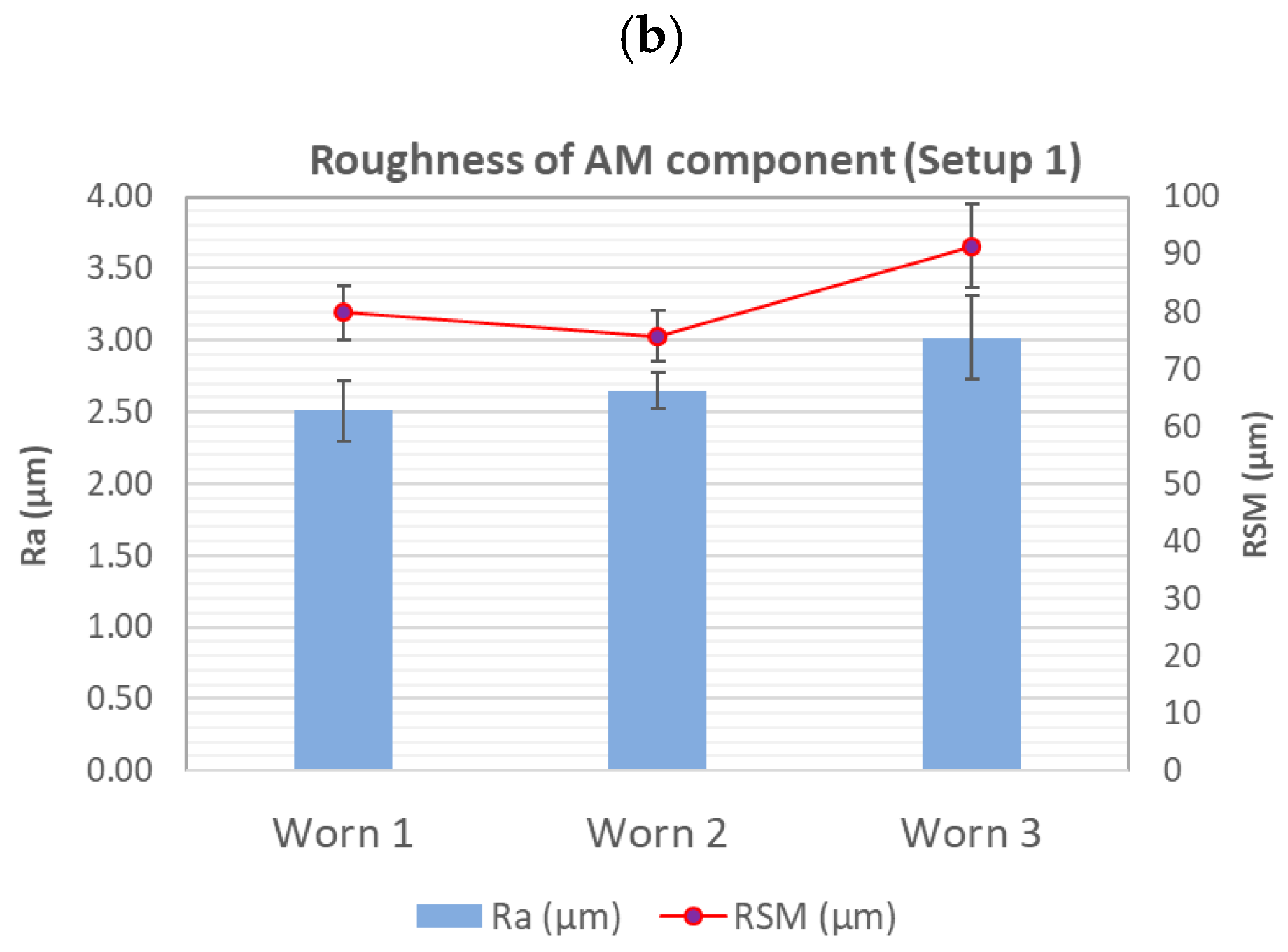



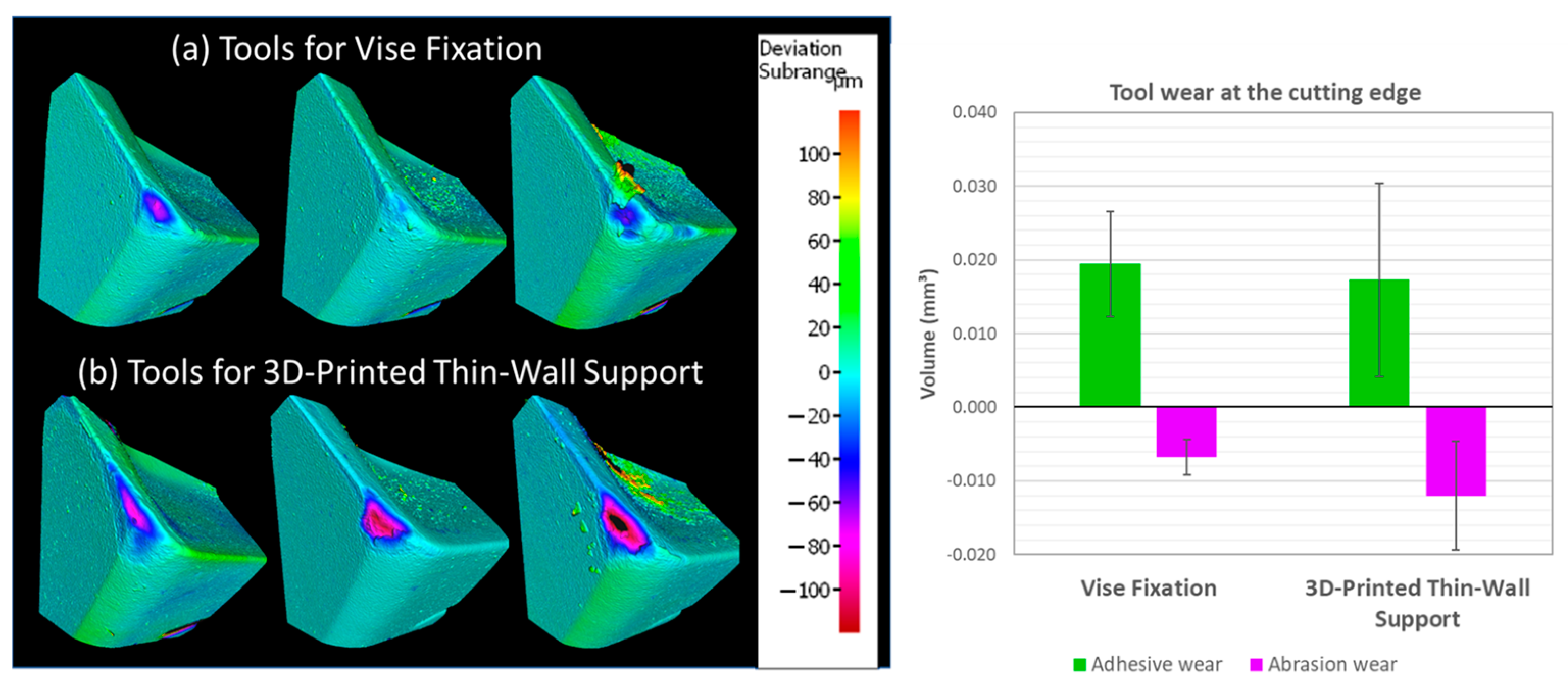
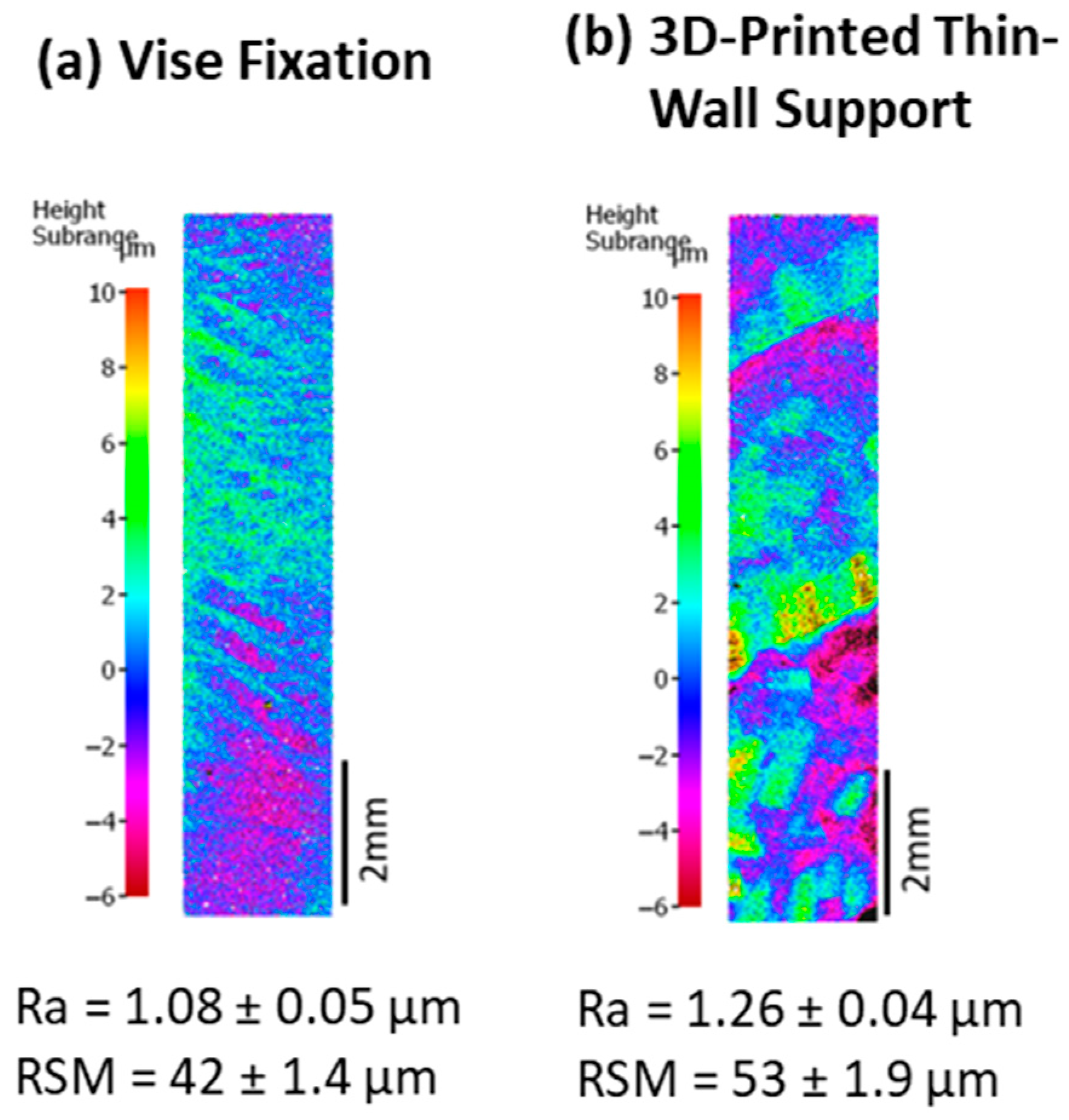
| Ti | Al | V | Fe | O | C | N | H | Res. | |
|---|---|---|---|---|---|---|---|---|---|
| Ti6Al4V powder for SLM | Balance | 5.5–6.5 | 3.5–4.5 | ≤0.25 | ≤0.13 | ≤0.08 | ≤0.05 | ≤0.012 | ≤0.41 |
| ASTM B265 Ti6Al4V alloy | Balance | 5.5–6.75 | 3.5–4.5 | ≤0.4 | ≤0.2 | ≤0.08 | ≤0.05 | ≤0.015 | ≤0.40 |
| Test Number | Ap (mm) | Fz (mm) | Trajectory |
|---|---|---|---|
| 1 | 0.1 | 0.1 | Linear |
| 2 | 0.1 | 0.5 | Linear |
| 3 | 0.25 | 0.1 | Linear |
| 4 | 0.1 | 0.1 | Trochoidal |
| 5 | 0.1 | 0.1 | Helical |
| Test Number | Ap (mm) | Fz (mm) | Ra (µm) | RSM (µm) | Passes | Max. Temperature (°C) | |
|---|---|---|---|---|---|---|---|
| Material | Tool | ||||||
| 1 | 0.1 | 0.1 | 1.34 ± 0.04 | 46 ± 1.7 | 1st | 203 | 93 |
| 2nd | 552 | 184 | |||||
| 3rd | 615 | 217 | |||||
| 4rt | 414 | 189 | |||||
| 2 | 0.1 | 0.5 | 1.37 ± 0.04 | 46 ± 1.7 | 1st | 423 | 90 |
| 2nd | 471 | 159 | |||||
| 3rd | 567 | 159 | |||||
| 4rt | 462 | 155 | |||||
| 3 | 0.25 | 0.1 | 1.45 ± 0.06 | 60 ± 2.5 | 1st | 650 | 280 |
| 2nd | <660 | 325 | |||||
| 3rd | <660 | 388 | |||||
Disclaimer/Publisher’s Note: The statements, opinions and data contained in all publications are solely those of the individual author(s) and contributor(s) and not of MDPI and/or the editor(s). MDPI and/or the editor(s) disclaim responsibility for any injury to people or property resulting from any ideas, methods, instructions or products referred to in the content. |
© 2025 by the authors. Licensee MDPI, Basel, Switzerland. This article is an open access article distributed under the terms and conditions of the Creative Commons Attribution (CC BY) license (https://creativecommons.org/licenses/by/4.0/).
Share and Cite
Garcia-Llamas, E.; Ramirez, G.; Fuentes, M.; Vidales, E.; Pujante, J. Exploring Post-Machining Alternatives Under Dry Conditions for Thin-Walled Additive Manufacturing Components Aided by Infrared Thermography. Processes 2025, 13, 717. https://doi.org/10.3390/pr13030717
Garcia-Llamas E, Ramirez G, Fuentes M, Vidales E, Pujante J. Exploring Post-Machining Alternatives Under Dry Conditions for Thin-Walled Additive Manufacturing Components Aided by Infrared Thermography. Processes. 2025; 13(3):717. https://doi.org/10.3390/pr13030717
Chicago/Turabian StyleGarcia-Llamas, Eduard, Giselle Ramirez, Miguel Fuentes, Eduard Vidales, and Jaume Pujante. 2025. "Exploring Post-Machining Alternatives Under Dry Conditions for Thin-Walled Additive Manufacturing Components Aided by Infrared Thermography" Processes 13, no. 3: 717. https://doi.org/10.3390/pr13030717
APA StyleGarcia-Llamas, E., Ramirez, G., Fuentes, M., Vidales, E., & Pujante, J. (2025). Exploring Post-Machining Alternatives Under Dry Conditions for Thin-Walled Additive Manufacturing Components Aided by Infrared Thermography. Processes, 13(3), 717. https://doi.org/10.3390/pr13030717







